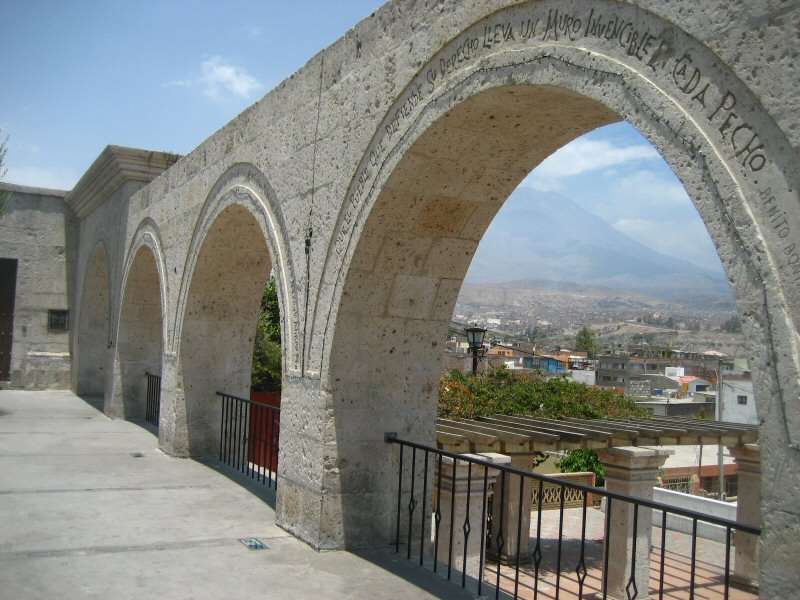sillar on:
[Wikipedia]
[Google]
[Amazon]
 Sillar is a variety of
Sillar is a variety of
Composition of sillar
from Maricopa Center for Learning and Instruction
Rhyolite Building stone Architecture in Peru {{Petrology-stub es:Toba volcánica#Sillar de Arequipa
 Sillar is a variety of
Sillar is a variety of rhyolite
Rhyolite ( ) is the most silica-rich of volcanic rocks. It is generally glassy or fine-grained (aphanitic) in texture (geology), texture, but may be porphyritic, containing larger mineral crystals (phenocrysts) in an otherwise fine-grained matri ...
, which is a type of volcanic rock
Volcanic rocks (often shortened to volcanics in scientific contexts) are rocks formed from lava erupted from a volcano. Like all rock types, the concept of volcanic rock is artificial, and in nature volcanic rocks grade into hypabyssal and me ...
. Although sillar is of rhyolitic composition, it has been erupted from volcano
A volcano is commonly defined as a vent or fissure in the crust of a planetary-mass object, such as Earth, that allows hot lava, volcanic ash, and gases to escape from a magma chamber below the surface.
On Earth, volcanoes are most oft ...
es which mostly erupt andesite
Andesite () is a volcanic rock of intermediate composition. In a general sense, it is the intermediate type between silica-poor basalt and silica-rich rhyolite. It is fine-grained (aphanitic) to porphyritic in texture, and is composed predomina ...
lava
Lava is molten or partially molten rock (magma) that has been expelled from the interior of a terrestrial planet (such as Earth) or a Natural satellite, moon onto its surface. Lava may be erupted at a volcano or through a Fissure vent, fractu ...
, and sillar contains small fragments of andesite. A pink variety of sillar owes its colour to crystal
A crystal or crystalline solid is a solid material whose constituents (such as atoms, molecules, or ions) are arranged in a highly ordered microscopic structure, forming a crystal lattice that extends in all directions. In addition, macros ...
s of hematite
Hematite (), also spelled as haematite, is a common iron oxide compound with the formula, Fe2O3 and is widely found in rocks and soils. Hematite crystals belong to the rhombohedral lattice system which is designated the alpha polymorph of . ...
within the rock. A white variety lacks these hematite crystals. Sillar is found as pyroclastic flow
A pyroclastic flow (also known as a pyroclastic density current or a pyroclastic cloud) is a fast-moving current of hot gas and volcanic matter (collectively known as tephra) that flows along the ground away from a volcano at average speeds of b ...
deposits of tuff
Tuff is a type of rock made of volcanic ash ejected from a vent during a volcanic eruption. Following ejection and deposition, the ash is lithified into a solid rock. Rock that contains greater than 75% ash is considered tuff, while rock co ...
near volcanoes in southern Peru
Peru, officially the Republic of Peru, is a country in western South America. It is bordered in the north by Ecuador and Colombia, in the east by Brazil, in the southeast by Bolivia, in the south by Chile, and in the south and west by the Pac ...
, for example the now-extinct Chachani volcano which erupted flows of sillar during the Pleistocene
The Pleistocene ( ; referred to colloquially as the ''ice age, Ice Age'') is the geological epoch (geology), epoch that lasted from to 11,700 years ago, spanning the Earth's most recent period of repeated glaciations. Before a change was fin ...
epoch
In chronology and periodization, an epoch or reference epoch is an instant in time chosen as the origin of a particular calendar era. The "epoch" serves as a reference point from which time is measured.
The moment of epoch is usually decided b ...
.
Sillar facies
In geology, a facies ( , ; same pronunciation and spelling in the plural) is a body of rock with distinctive characteristics. The characteristics can be any observable attribute of rocks (such as their overall appearance, composition, or con ...
Orvieto-Bagnoregio Ignimbrite
Ignimbrite is a type of volcanic rock, consisting of hardened tuff. Ignimbrites form from the deposits of pyroclastic flows, which are a hot suspension of particles and gases flowing rapidly from a volcano, driven by being denser than the surrou ...
(black blocks of scoria
Scoria or cinder is a pyroclastic, highly vesicular, dark-colored volcanic rock formed by ejection from a volcano as a molten blob and cooled in the air to form discrete grains called clasts.Neuendorf, K.K.E., J.P. Mehl, Jr., and J.A. Jackso ...
in red tuff) occurs at Civita di Bagnoregio in the Vulsini volcanic district of central Italy.Palladino D.M. et al. (2014) ''Bolsena, Latera and Vico calderas, central Italy'', IAVCEI Field Guide Series 3, page 29
Building stone
Sillar has been used as a building stone in Peru. Many colonial buildings in the city ofArequipa
Arequipa (; Aymara language, Aymara and ), also known by its nicknames of ''Ciudad Blanca'' (Spanish for "White City") and ''León del Sur'' (Spanish for "South's Lion"), is a city in Peru and the capital of the eponymous Arequipa (province), ...
are made of sillar, for example, the arches of the "Mirador of Yanahuara" in Arequipa, from which the entire city can be viewed.
See also
* * * *References
Composition of sillar
from Maricopa Center for Learning and Instruction
Rhyolite Building stone Architecture in Peru {{Petrology-stub es:Toba volcánica#Sillar de Arequipa